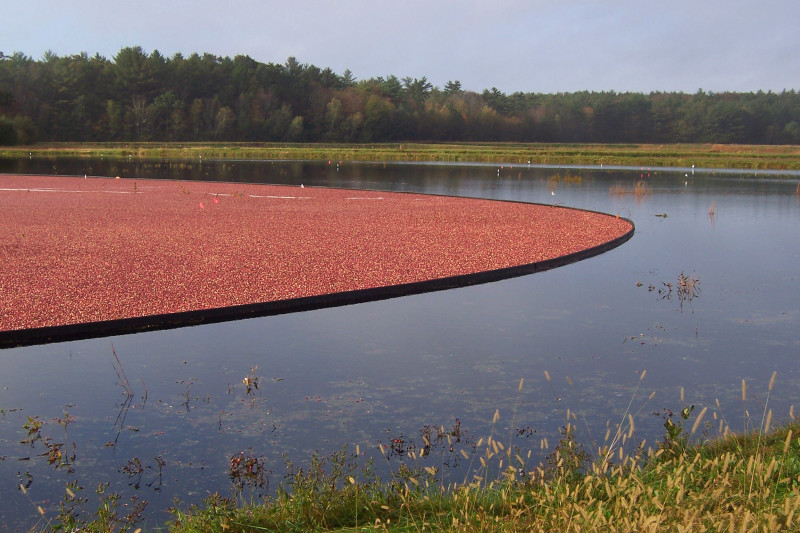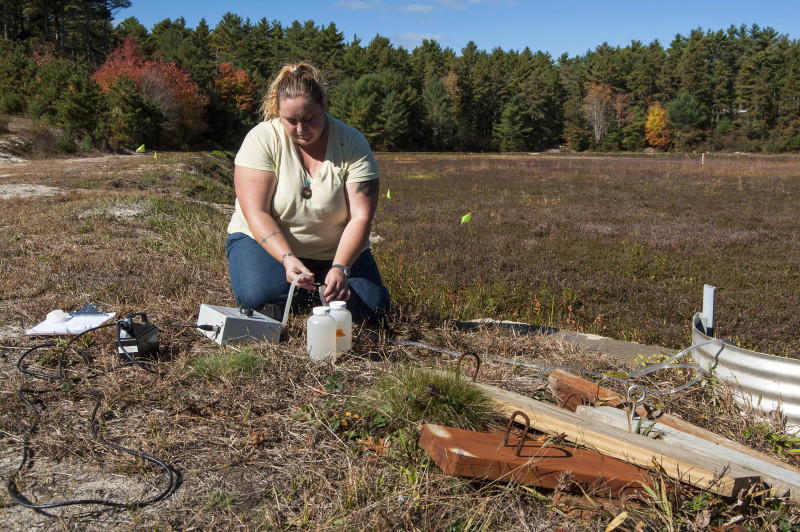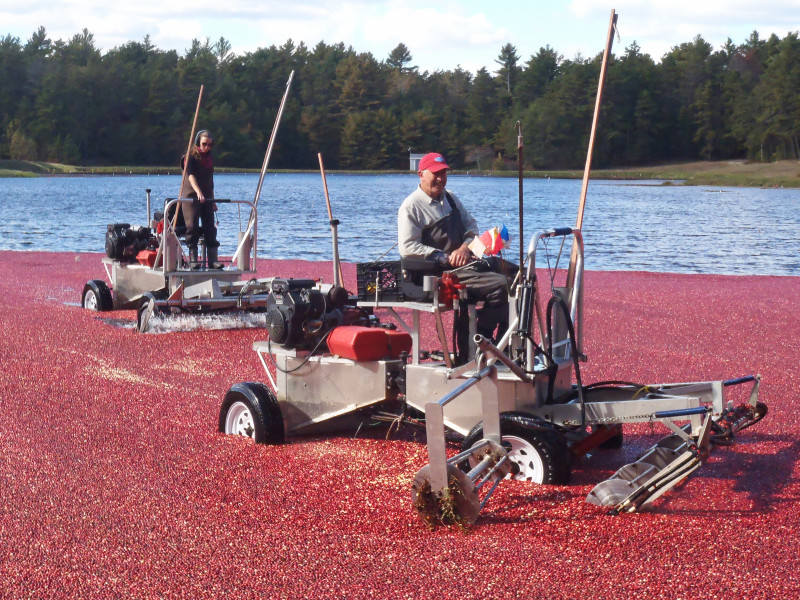Kirby Gilmore has been growing cranberries his whole life. For the past 35 years, he’s farmed 50 acres of bogs in Carver and South Middleborough, near streams that flow to two of Buzzards Bay’s largest rivers: the Weweantic and the Wareham. His bogs provide the ripe red cranberries that grace our Thanksgiving tables – and now, these same bogs are providing valuable science that will help Buzzards Bay’s cranberry industry protect clean water.
Cranberry bogs like Gilmore’s are an important part of our landscape and heritage in southeastern Massachusetts. But with so many bogs in the Buzzards Bay region, cranberry agriculture can be source of nitrogen pollution to our waterways. The Coalition is now partnering with growers to develop new research on cranberry bogs to help solve this piece of the Bay’s nitrogen pollution puzzle.
Why do cranberry bogs pose a problem for our local waters?

Fall’s flooded cranberry bogs are scenic — but with all that flood water comes a nutrient called nitrogen, which is the biggest type of pollution fouling Buzzards Bay.
The Buzzards Bay region is home to lots of cranberry bogs – 8,000 acres of them, to be exact. One-fifth of the nation’s commercial cranberry crop is grown in the Buzzards Bay region. There’s a greater density of cranberry bogs here than in any coastal area in the world.
These cranberry bogs are located across the Buzzards Bay watershed, from Acushnet to Falmouth. But they’re concentrated around the Weweantic River and the Sippican River, the Bay’s largest freshwater river system. The Weweantic/Sippican river system begins in Carver and flows through Middleborough and Rochester before reaching the shores of Marion and Wareham, where it empties into Buzzards Bay. The Wareham River system, including the Agawam River and the Wankinco River, is also dense with cranberry bogs.
Cranberry bogs are an important part of the landscape here in the Buzzards Bay region. They maintain thousands of acres of wetlands, which help protect the Bay. They also provide important wildlife habitat for ducks, turtles, otters, turkeys, and more.
However, cranberry agriculture can pose a problem for the health of our local waters. Like most commercial crops, cranberries need fertilizer to grow. Cranberry bogs also require a lot of water, which comes from nearby ponds and rivers.
In fall, when cranberries are ready for harvest, growers flood their bogs and gather up the ripe berries floating on the water’s surface. Then they release the leftover water back into the nearest pond or river. Along with all of that water movement comes excess nutrients – namely, nitrogen and phosphorus left over from applying fertilizer.
How much nitrogen pollution comes from cranberry bogs?
With so many bogs in one place, cranberry agriculture is certainly a source of nitrogen pollution: the greatest long-term threat to the health of Buzzards Bay’s coastal waters. But it’s not the only source of this harmful pollution that fouls the Weweantic River, the Wareham River, and other nearby rivers that drain to the Bay.
Nitrogen pollution in Buzzards Bay is like a big puzzle. The largest pieces are from septic systems and wastewater, and smaller pieces are from things like lawn fertilizer and polluted stormwater runoff. How do cranberry bogs fit into this nitrogen pollution puzzle? That depends on many factors – some that we’re still working to uncover.
The density of cranberry bogs in an area is one factor. For example, in the Weweantic River and the Wareham River – the two river systems with the most cranberry bogs in their watersheds – anywhere from a quarter to more than half of nitrogen pollution may be coming from cranberry agriculture.
Even in areas with lots of cranberry bogs, nutrient runoff varies widely from bog to bog. There are several different types of cranberry bogs, and all growers manage their bogs differently.
In short, there is no one-size-fits-all method for estimating how much nitrogen pollution comes from a cranberry bog, or for reducing the amount of fertilizer that runs off bogs. That’s why researchers are now working to better understand the impact of cranberry agriculture on Buzzards Bay.
How is the Coalition working to solve nitrogen pollution from cranberry bogs?
To solve the puzzle of nitrogen pollution from cranberry bogs, the Coalition has brought together a unique partnership of cranberry growers, agricultural scientists, coastal ecologists, and municipal government officials on a multi-year research project. This study is already helping us better understand the amount of nutrients that come from cranberry bogs.
With this research, the partnership hopes to create recommendations for the cranberry industry to manage bogs in a way that protects clean water. The research will also lead to more effective plans to restore the Weweantic River and the Wareham River.
Research on active cranberry bogs

In the first phase of a new study on cranberry bogs, researchers with the UMass Cranberry Station collected water samples from six local cranberry bogs. These samples were analyzed for nutrients at the Marine Biological Laboratory in Woods Hole.
Together with the UMass Cranberry Station, the Marine Biological Laboratory in Woods Hole, the Cape Cod Cranberry Growers’ Association, and the town of Carver, the Coalition is spearheading research on cranberry bogs in the Buzzards Bay region. This multi-year study, which began in 2011, is measuring nutrient runoff from different types of cranberry bogs at different times of the year.
Prior to this project, the main research on nitrogen pollution from cranberry bogs was nearly 20 years old. This early study showed that cranberry bogs release a significant amount of nutrients – but the study only examined an old-style bog that’s now uncommon in the Buzzards Bay region.
The first phase of our new research looked at more common types of cranberry bogs. At six separate bogs in Wareham, Carver, Plymouth, and Middleborough, researchers collected water samples throughout a one-year period to measure the amount of nutrients that run off cranberry bogs.
We’re now zeroing in on post-harvest flood waters – when growers release lots of water (and nutrients) from their bogs. Using automated samplers, researchers are collecting multiple water samples during these flood, such as after the autumn harvest and winter frost protection floods. With this technology, we can estimate more precisely when and how much nitrogen cranberry bogs release after floods.
This research will provide us with important, long-overdue science about the various factors that determine how much nitrogen pollution comes from cranberry bogs around Buzzards Bay.
Management recommendations for cranberry growers and waterway cleanup plans

Cranberry grower Kirby Gilmore is already putting to use on his own bogs new information about nutrient management from the Coalition’s cranberry study. (Image: Kirby & Carolyn Gilmore)
The cranberry study is already yielding new information about nutrient management that grower Kirby Gilmore is putting to use on his own bogs – two of which have been part of the research project.
For instance, researchers have found that more nutrients come off cranberry bogs at the very end of the release of flood waters. By adjusting how water is released after harvest, cranberry growers may be able to make a big difference for the health of waters downstream.
With the results of this study, the Coalition hopes to make these types of real-world recommendations so cranberry growers can better manage their bogs for nutrients. Through partnerships with growers like Gilmore and the UMass Cranberry Station, we can make the Buzzards Bay cranberry industry a national leader in nutrient management and clean water protection.
Federal, state, and local officials can also use this new research to guide cleanup plans for waterways near cranberry bogs, including the Weweantic River and the Wareham River. By gathering this sound science on nutrient runoff from cranberry bogs, we can properly weigh each piece of the nitrogen pollution puzzle and develop effective plans to restore the health of our rivers.